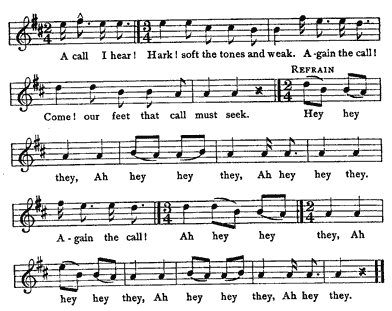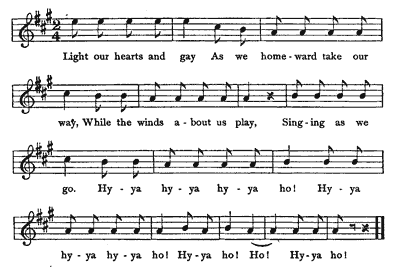The Life of the Corn
by Alice C. Fletcher
Dance III - The Corn Springs Up
INTRODUCTORY NOTE.—This dance is from the Corn Ritual Song and is a dramatization of a visit to the planted field after the lapse of a few weeks. Life has been stirring in the kernels of corn that had been hidden within the little hills, and the kernels now call to those who had planted them to come and see what was taking place.
Properties.—The same as those used in the preceding dance. Both the boys and the girls should wear the same costume as in Dance II.
Directions.—The scene should be the same as in Dance II. The "field" to be visited should be in the same place as the space set apart for the "field" where the little hills were made and planted.
A part of the boys should act as guards of the "field" as before. A few should scatter among the girls and join in looking at the sprouting corn as it breaks through the soil, and these should join in singing the song.
At the opening of the dance the dancers should be discovered standing in groups as though they had accidentally met as neighbors of the same village. They should stand at the same place whence they had started to go to the "field" in the preceding dance. The groups should be talking in dumb show. Suddenly each group should act as if its attention had been arrested by a sound, and while in this attitude of arrested attention all should begin to sing the following song:
Song
1
A call I hear!
Hark! soft the tones and weak.
Again the call!
Come! our feet that call must seek.
Refrain: Hey hey they,
Ah hey hey they,
Ah hey hey they,
Again the call!
Ah hey hey they,
Ah hey hey they,
Ah hey hey they,
Ah hey they.

This dramatic dance will require to be rehearsed and the details planned by the dancers, so that a clear picture may be brought out and also the native poetic thought embodied in the Ritual Song from which it is taken. A few hints can be given, but much of the action must depend upon the imagination and dramatic feeling of the dancers.
As the first line, "A call I hear!" is sung some one should raise the hand toward the ear, another raise it as a warning to keep quiet. The line "Hark! soft the tones and weak" is an address to one another in the groups. Then comes another sudden arrest, "Again the call!" These three lines should be sung without any change of position either by the groups or by the individuals. Action should be confined to the hands and the head. When singing the fourth line all should begin to stir, to adjust their pouches, tighten their hold on the wooden hoes and, as if moved by a common impulse, should prepare to go and seek the source of the call. In their going the groups should not fall into one line but each group move by itself. During the refrain the dancers should act as if in doubt which way to go. At the line "Again the call!" all should stop as if arrested, and then move off again when the refrain is taken up. All the groups should keep the rhythm of the music. There should be a good deal of by-play and the action should indicate bewilderment, both as to the meaning of the call and the locality whence it comes. It should appear as though some of the groups are baffled in their attempt to locate the call.
2
A call I hear!
Hark! it is near at hand,
The call! The call!
Floats to us where we now stand.
Refrain: Hey hey they,
Ah hey hey they,
Ah hey hey they,
Again the call!
Ah hey hey they,
Ah hey hey they,
Ah hey hey they,
Ah hey they.
The action of this stanza shows the dancers being led by the call to the "field," where the call seems to become clearer and at last is there located. The dancers should scatter in groups, while different individuals should look about searchingly but without breaking the groups. These should move here and there seeking for the "footprints" that had been left on the smooth tops of the little hills, and so lead to the action required for the next stanza. Whenever in the song the line "The call! The call!" occurs, there should be an apparent arrest of movement among the dancers as if to listen.
3
Again the call!
Forth to the light of day
They come! They come!
Come pushing upward their way.
Refrain: Hey hey they,
Ah hey hey they,
Ah hey hey they,
They call! They come!
Ah hey hey they,
Ah hey hey they,
Ah hey hey they,
Ah hey they.
"Day" is the symbol of life; the kernels are coming "into the light of day" in the original Ritual Song, meaning they are entering into life. They call as they come, struggling and pushing their way through the breaking earth. This life movement should be indicated by the motions of the dancers as they pass in groups with rhythmic steps from one little hill to another. Directions as to how these motions should be made would hardly be helpful; the dancers can best plan this pantomime.
4
Again the call!
Two feeble leaves are seen,
They call! They call!
Soon shall we stand clad with green!
Refrain: Hey hey they,
Ah hey hey they,
Ah hey hey they,
They call! They call!
Ah hey hey they,
Ah hey hey they,
Ah hey hey they,
Ah hey they.
The original Ritual Song tells that the feeble leaves, the first shoots, cannot stand or support themselves; they are helpless as infants. But they have come to the "light of day," "have entered into life," and they will grow, become strong and stand, stretching ever higher into the light. The native stanzas portray the progressive movements of the corn from feeble helplessness into the power of life. The action of the dancers should convey this meaning by appropriate pantomime.
5
They call! They call!
Up springs our jointed stem,
They call! They call!
Golden fruit shall grow on them.
Refrain: Hey hey they,
Ah hey hey they,
Ah hey hey they,
They call! They call!
Ah hey hey they,
Ah hey hey they,
Ah hey hey they,
Ah hey they.
In this stanza the promise of fruit is given. The dancers should show excitement not only at the wonderful spectacle they observe but because of the promise given.
They should still keep in groups as they move about and exult in the results that have come from the little hills where they left their "footprints."
In the original Ritual Song there are more than a score of stanzas in which the various occurrences of the growth of the corn are mentioned, mingled with symbolic imagery. "Footprints" represent both labor and ownership. Those who planted the kernels look for these marks and rejoice over what they find. They had begun their planting "like a game," a venture; whether it would be successful or not no one could tell. But success had come. The action for the last stanza should indicate an abandonment to delight; hoes should be dropped as the groups mingle and act out pleasure not only at what is seen but what is promised.
A pause should follow, then the hoes should be picked up and the dancers gather by twos and threes in a line to return home; as they start they break into the same song which they sang on the return from making and planting the little hills:

The dancers should keep up the song and rhythmic dance until their individual tents are reached.